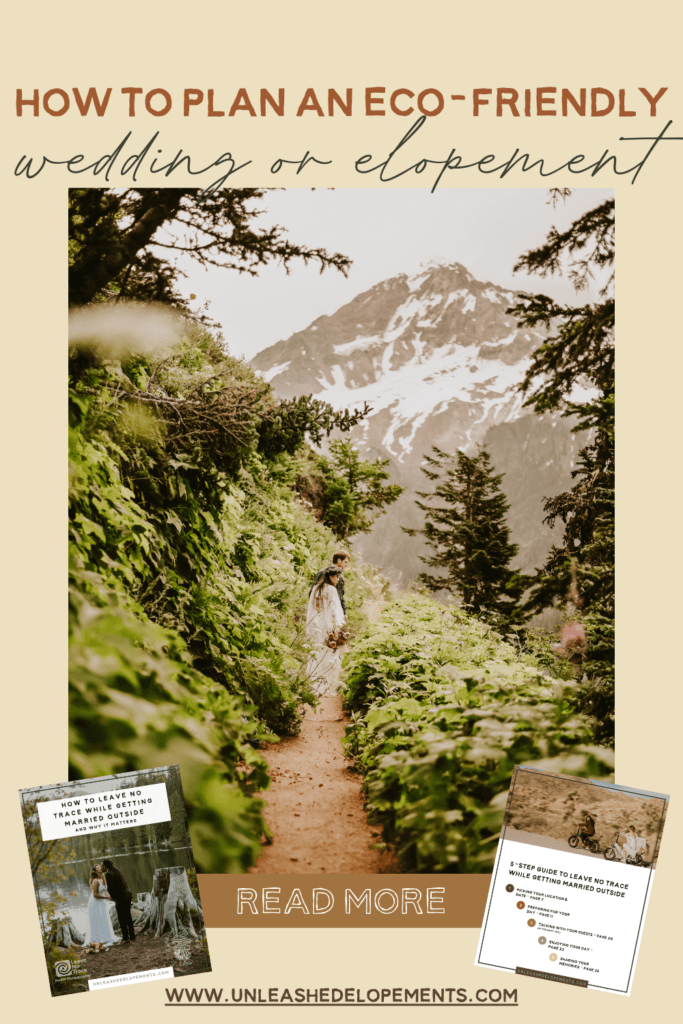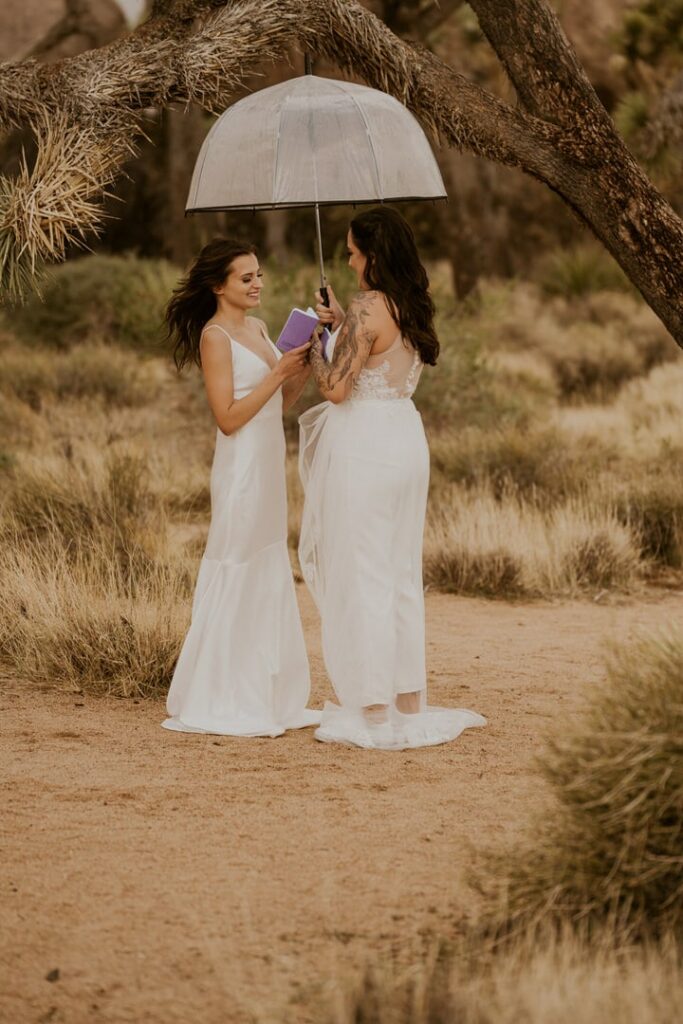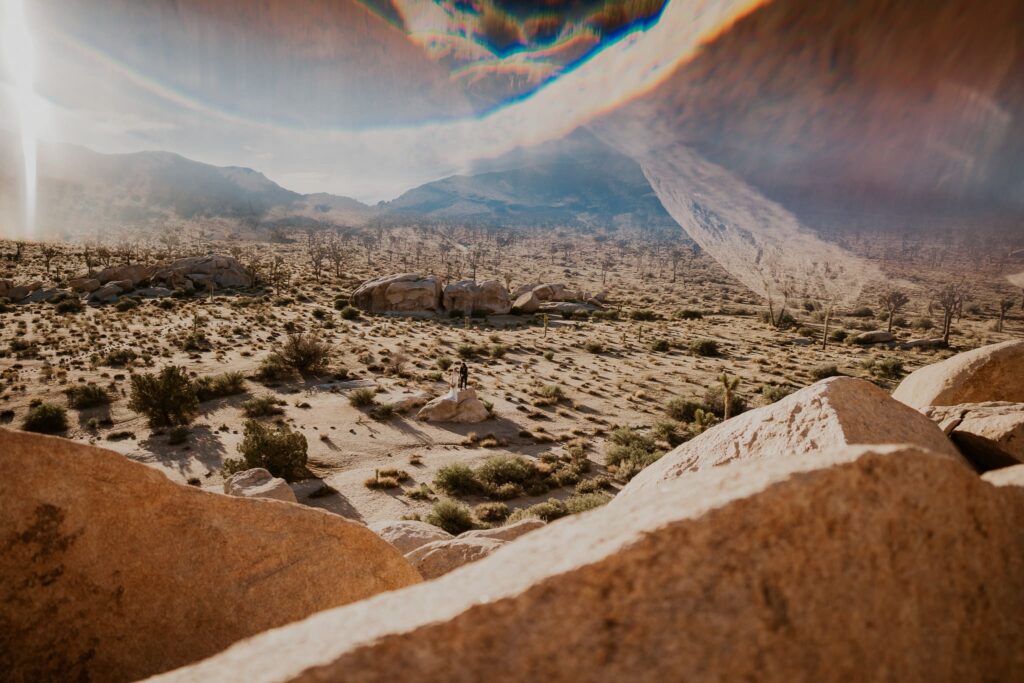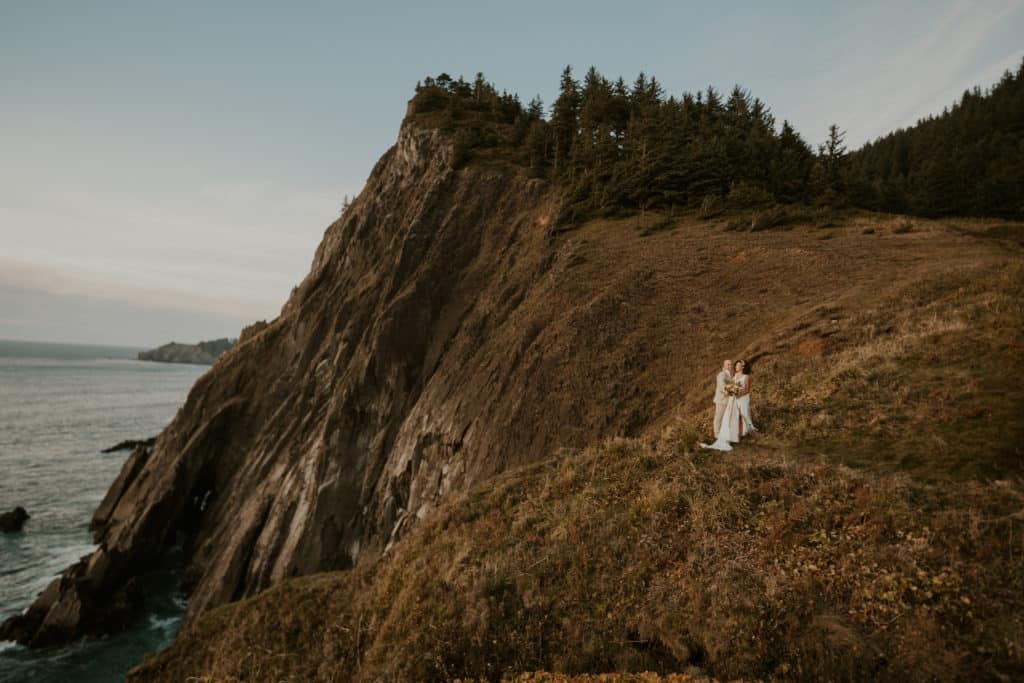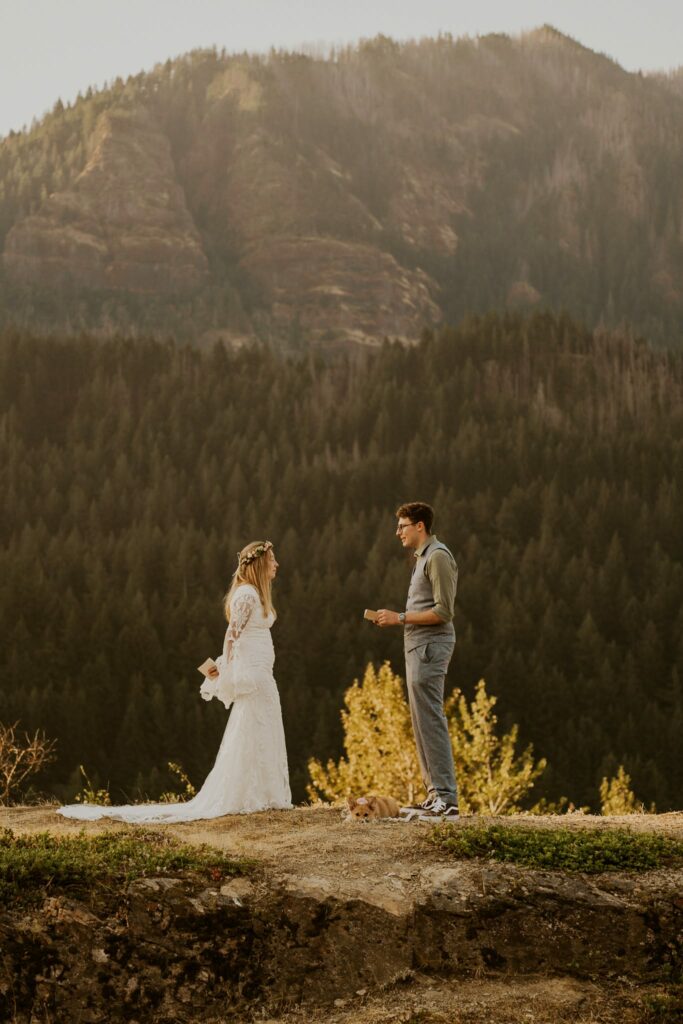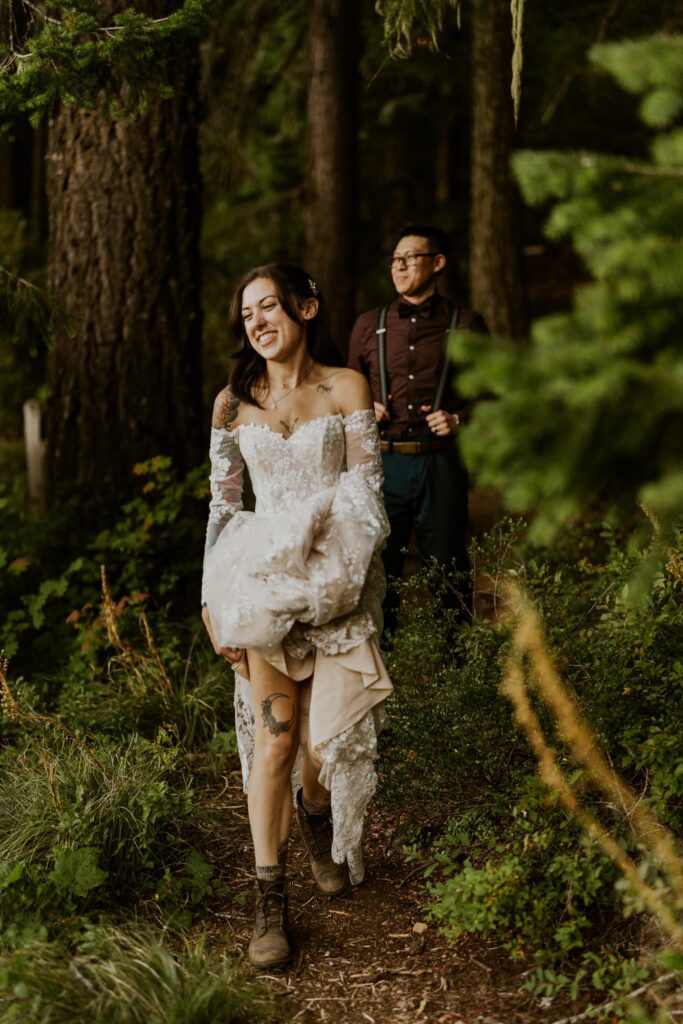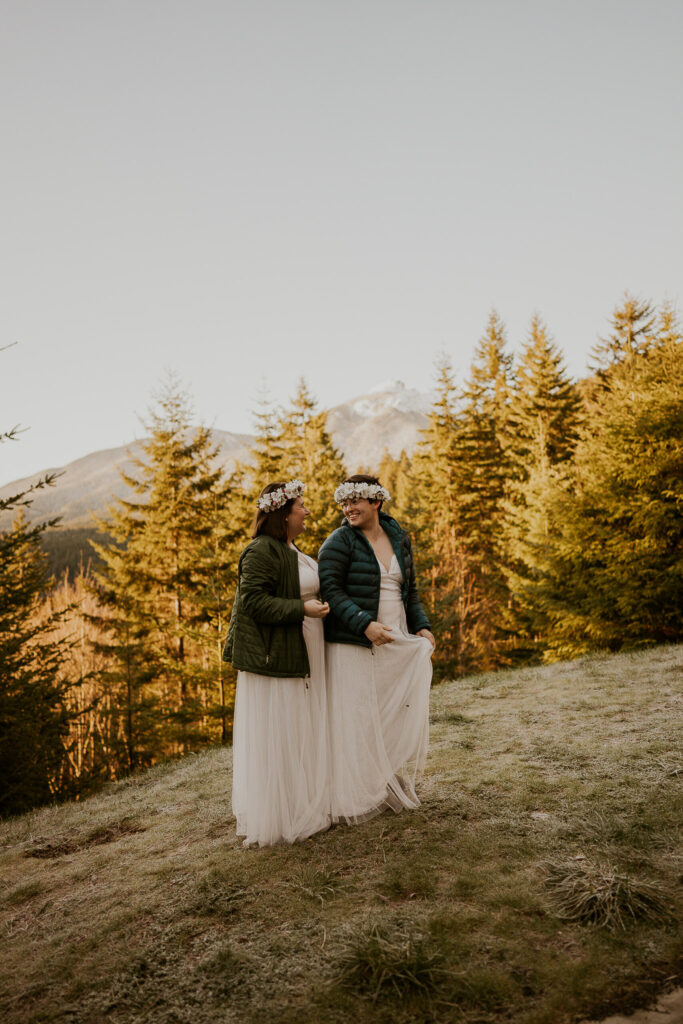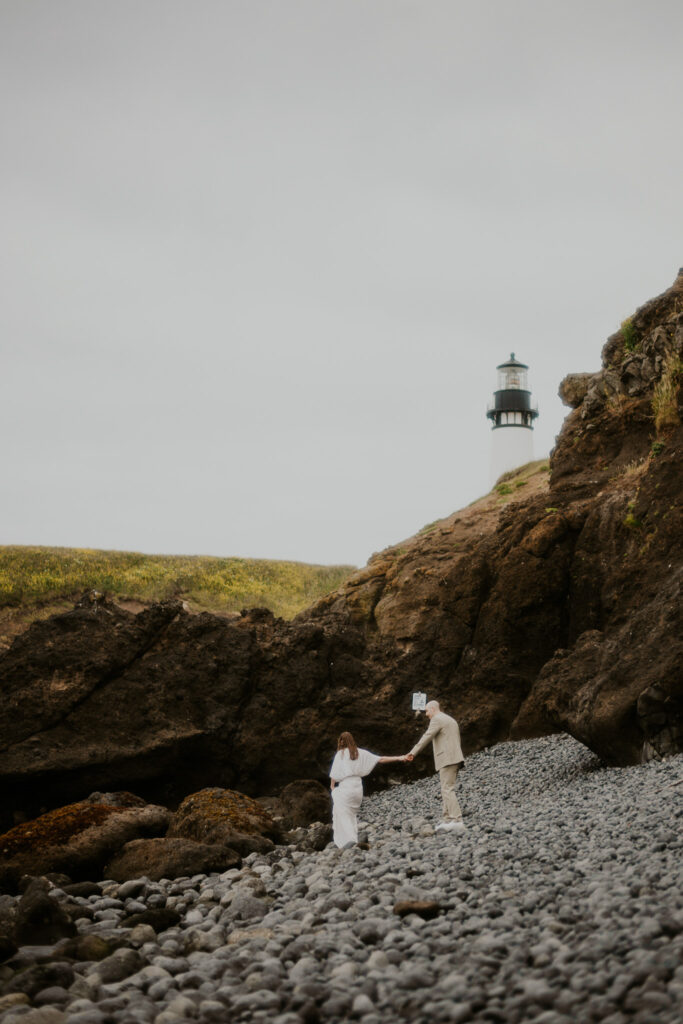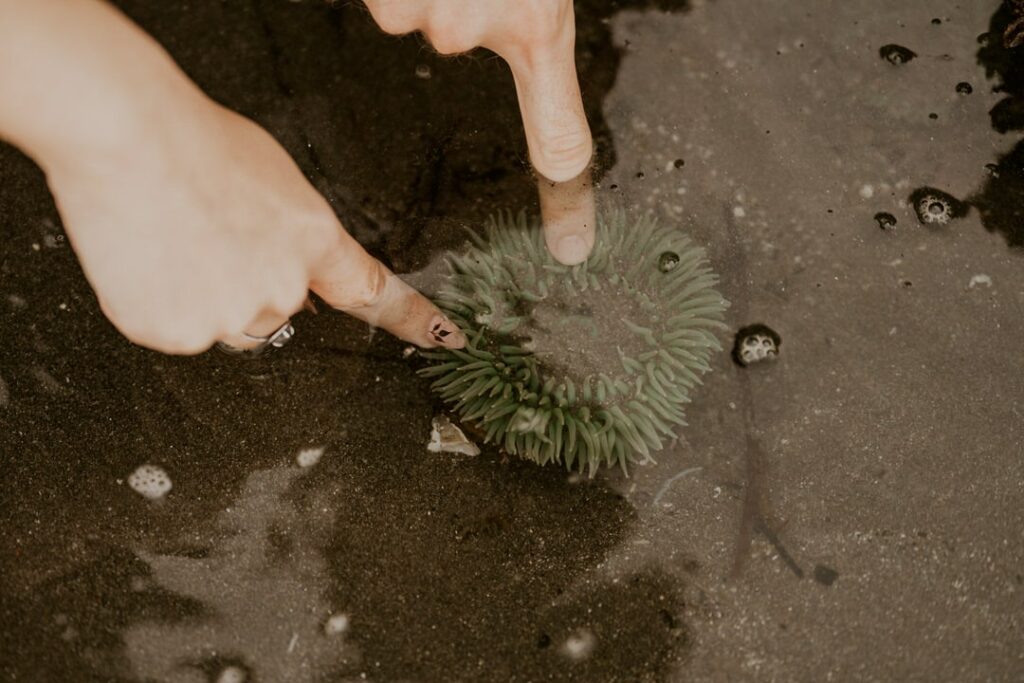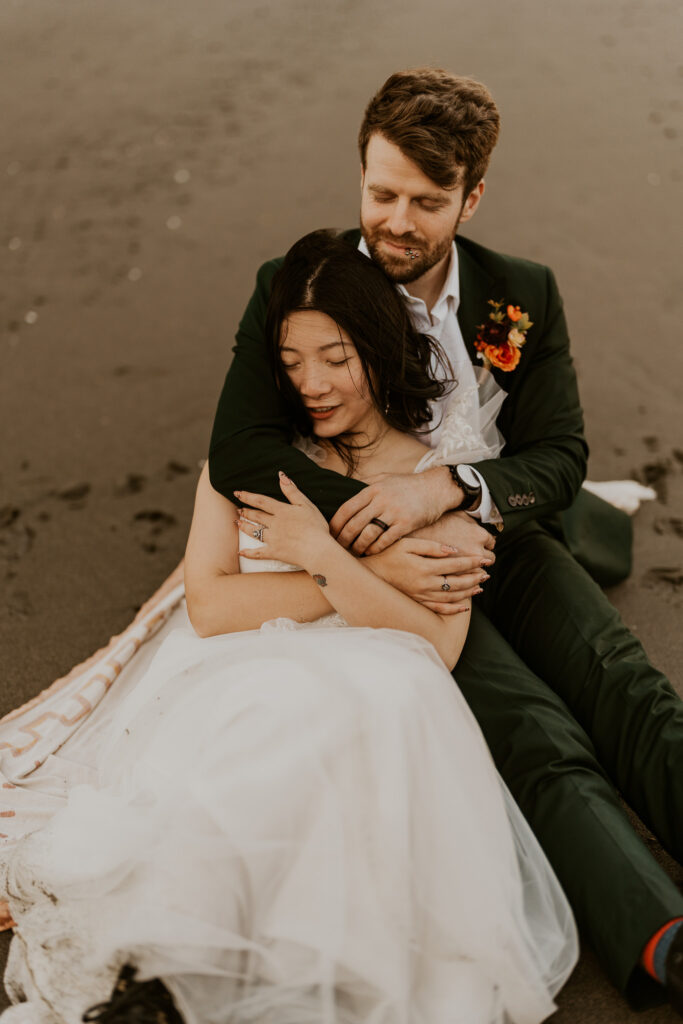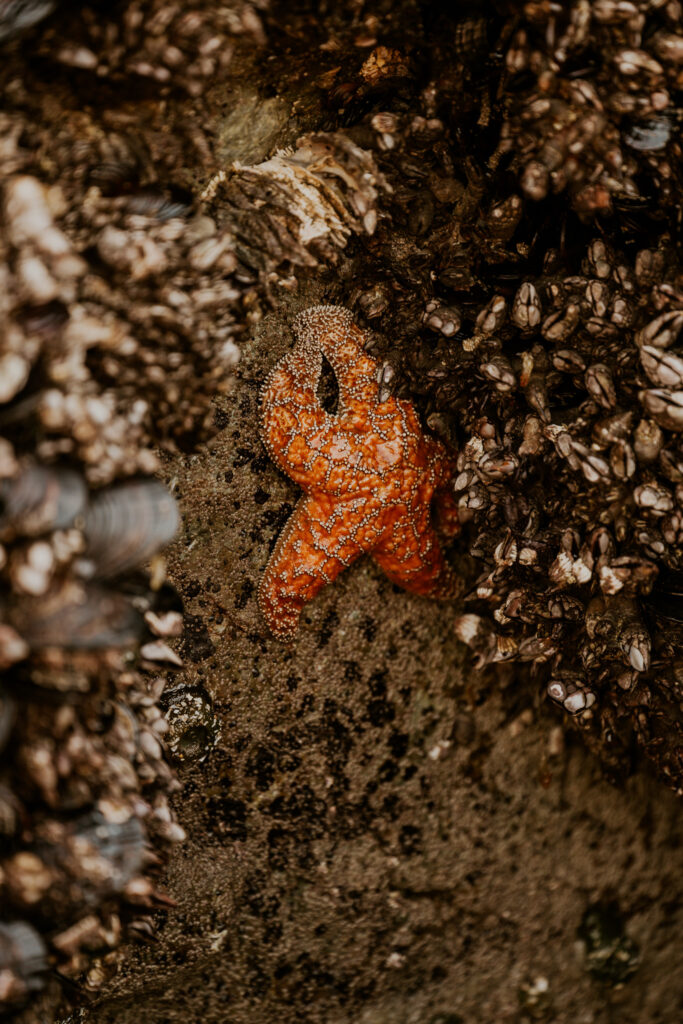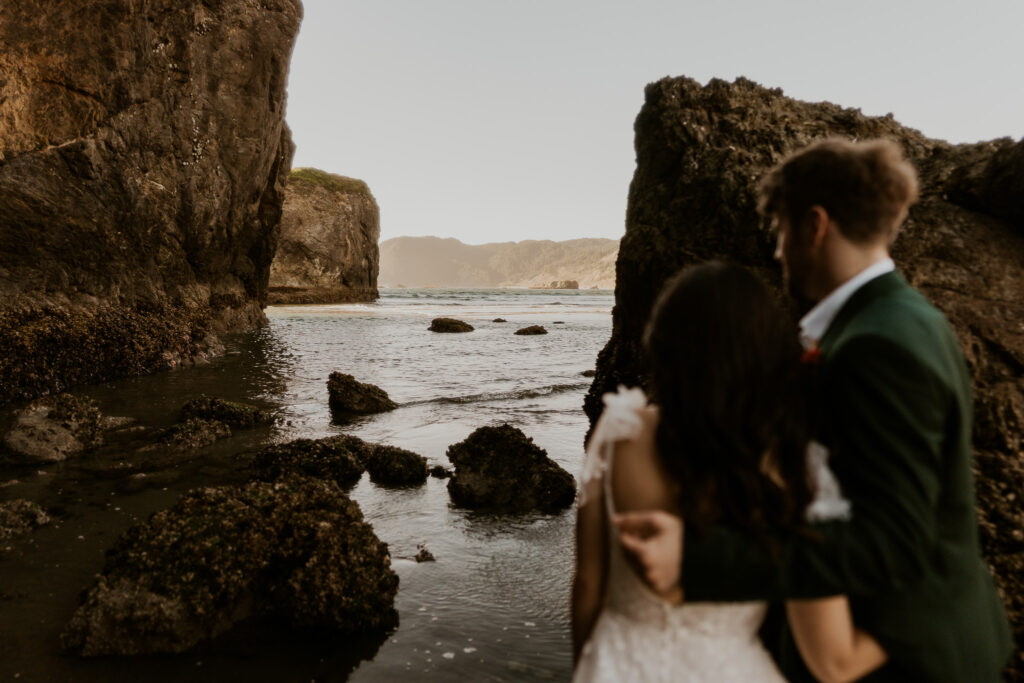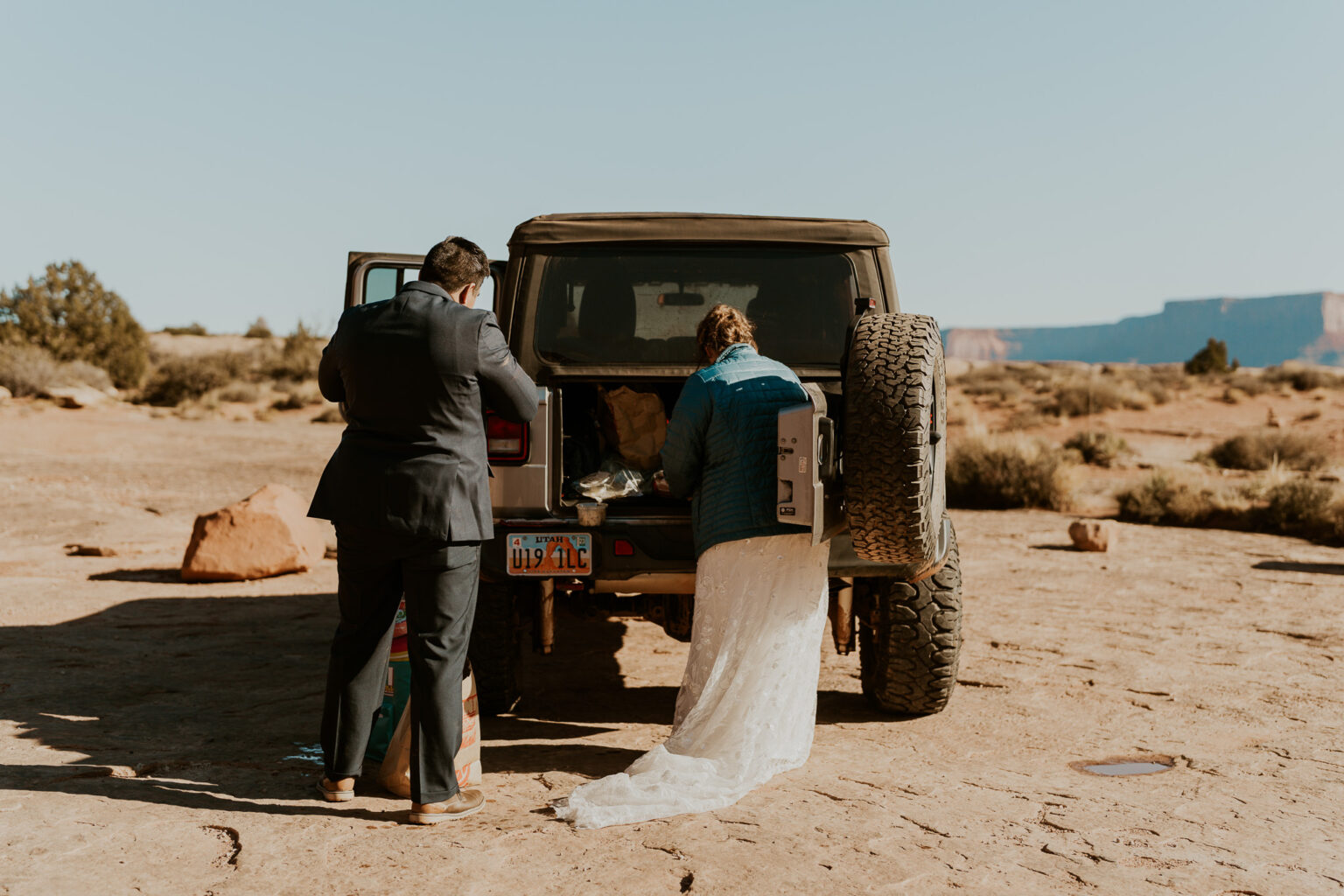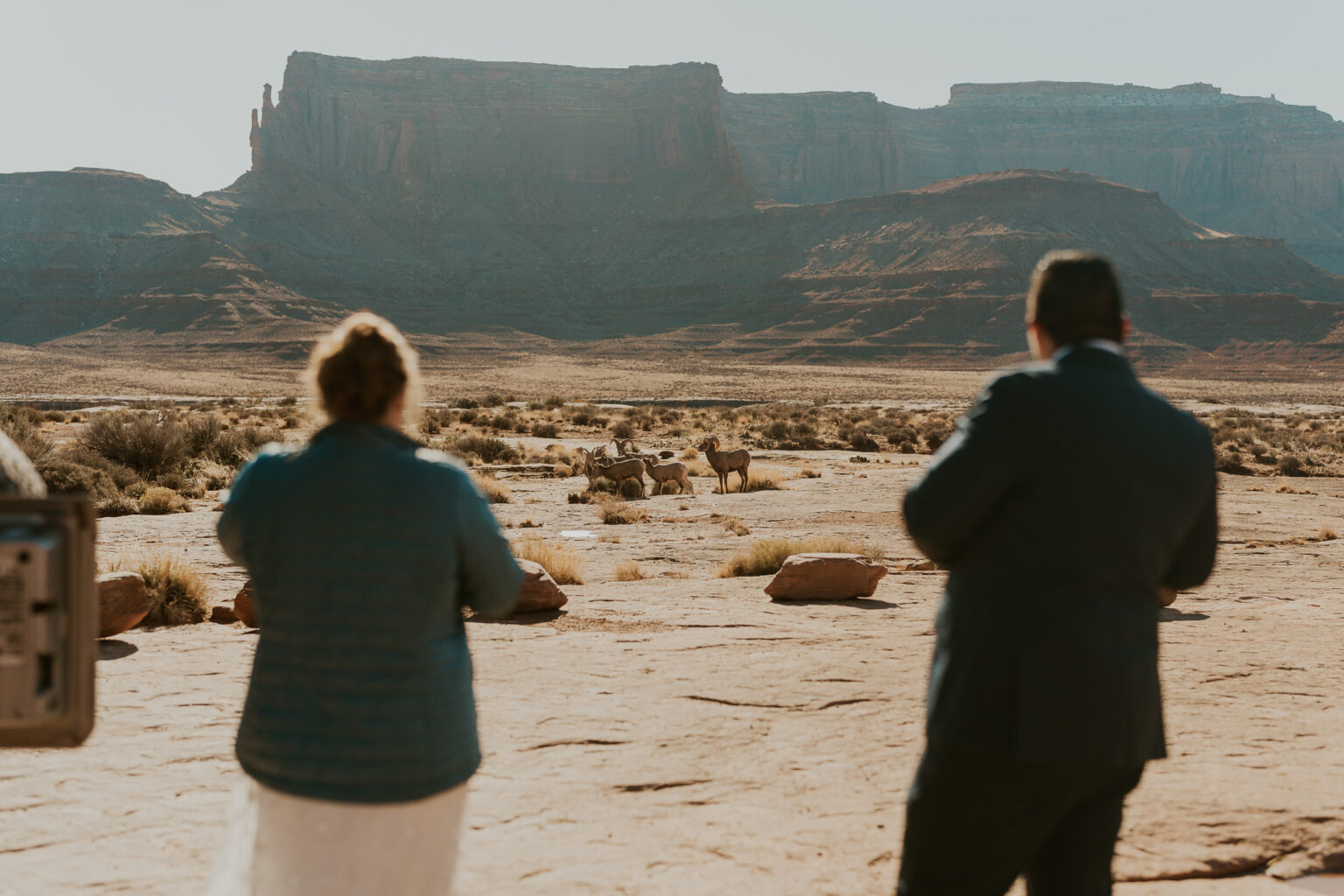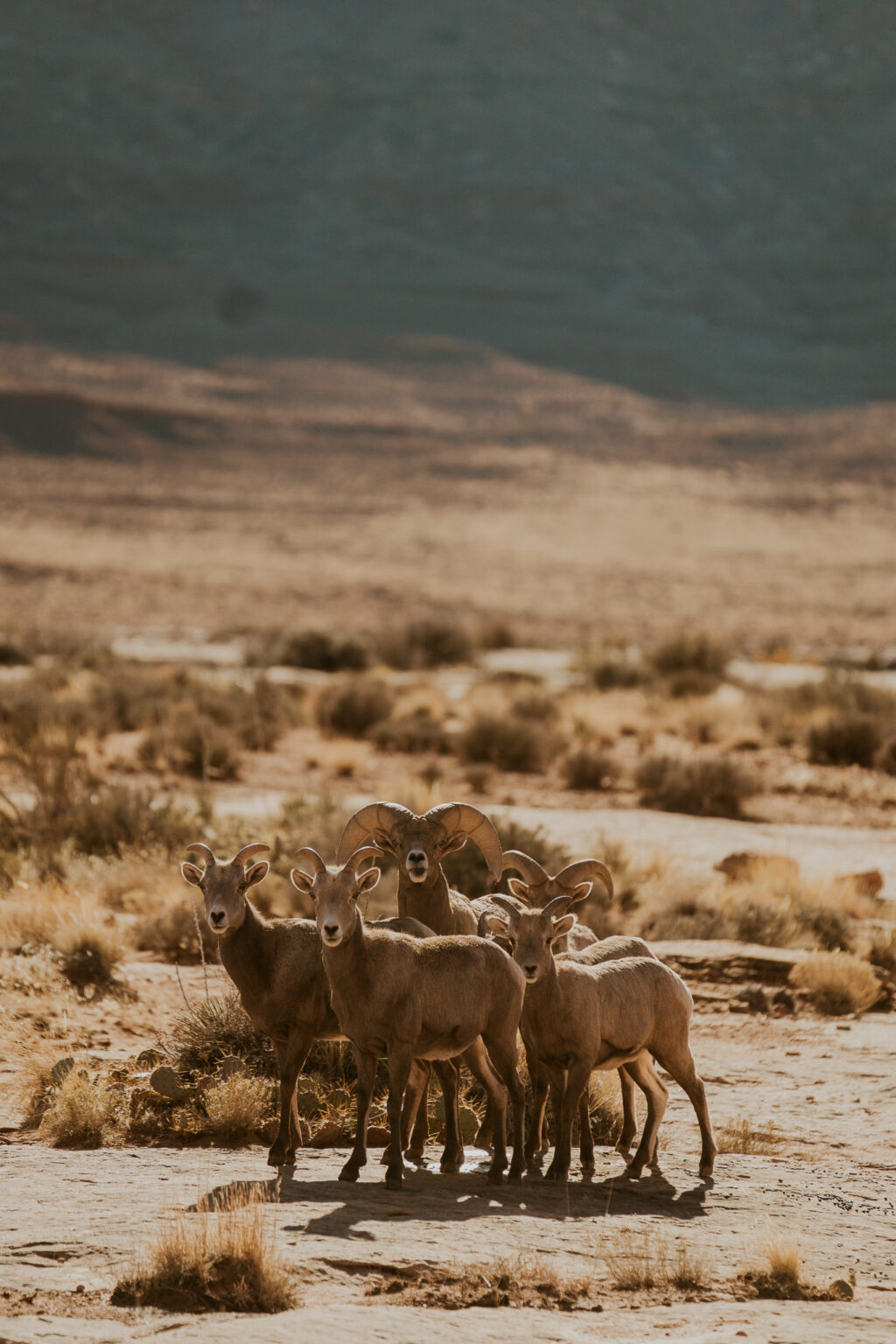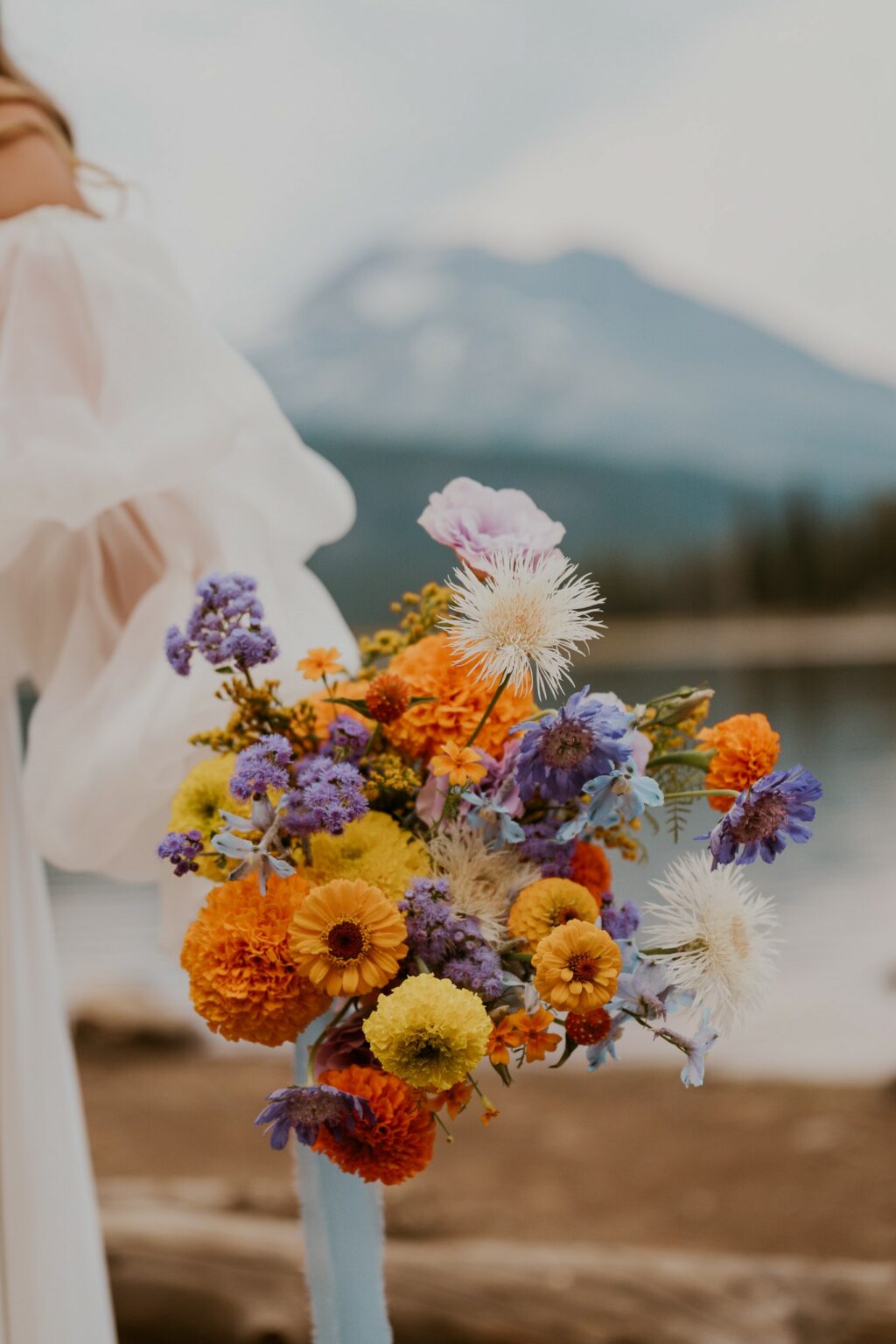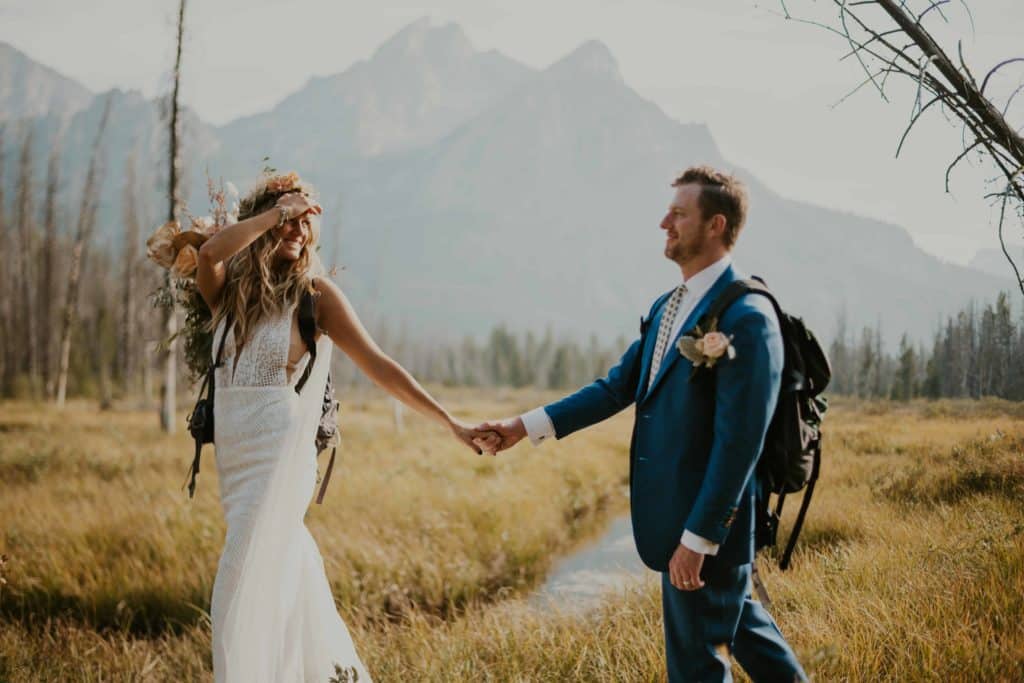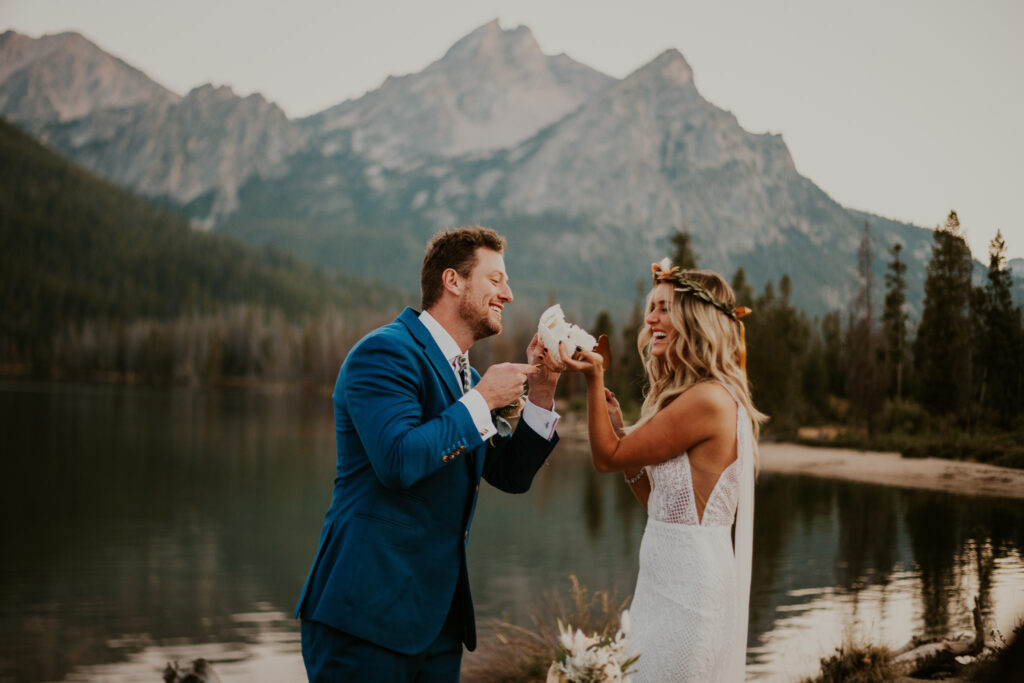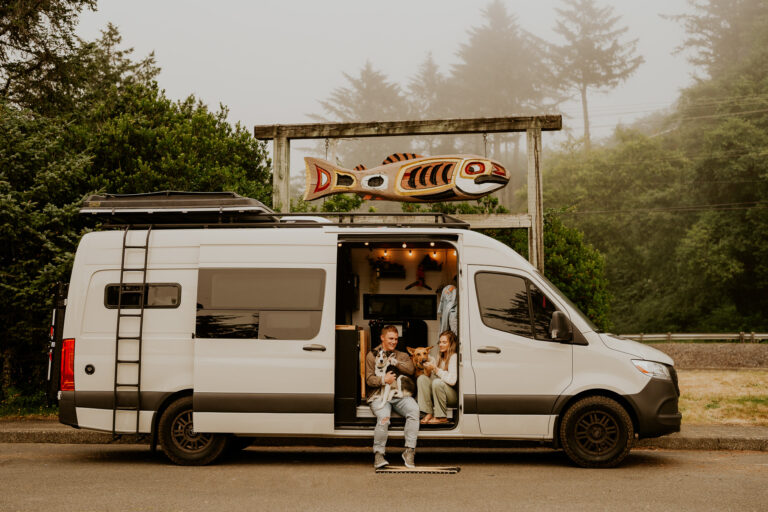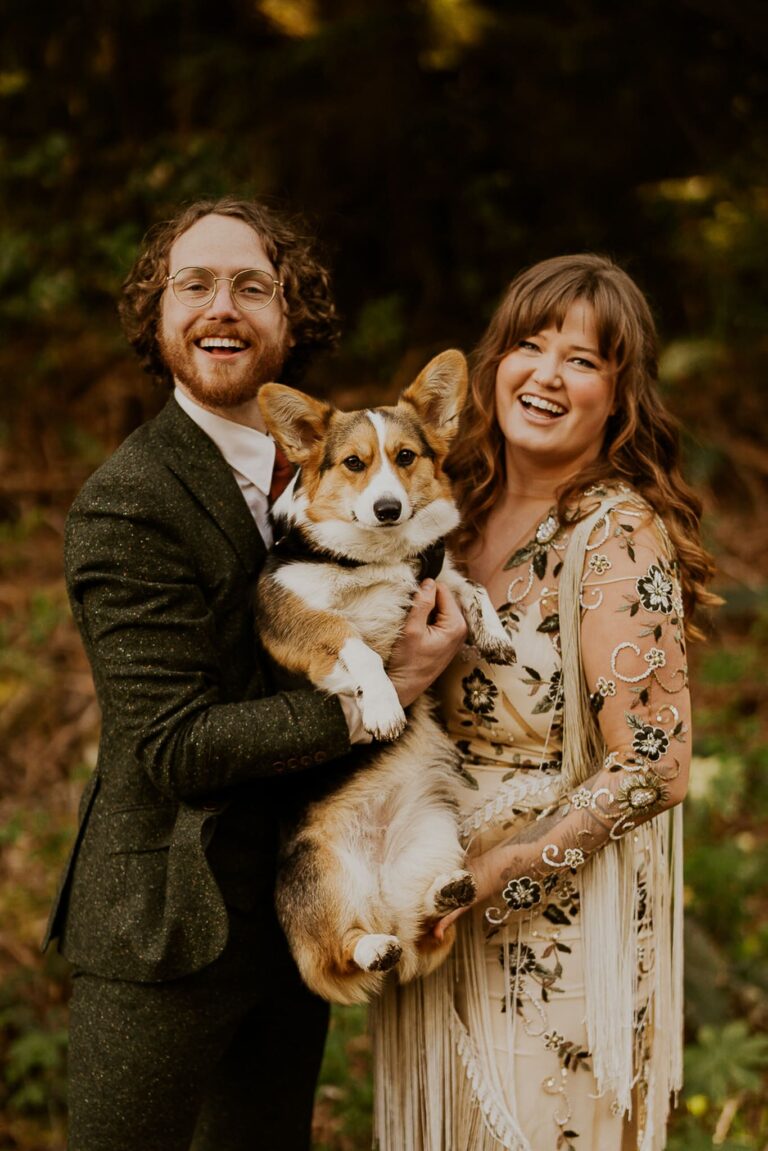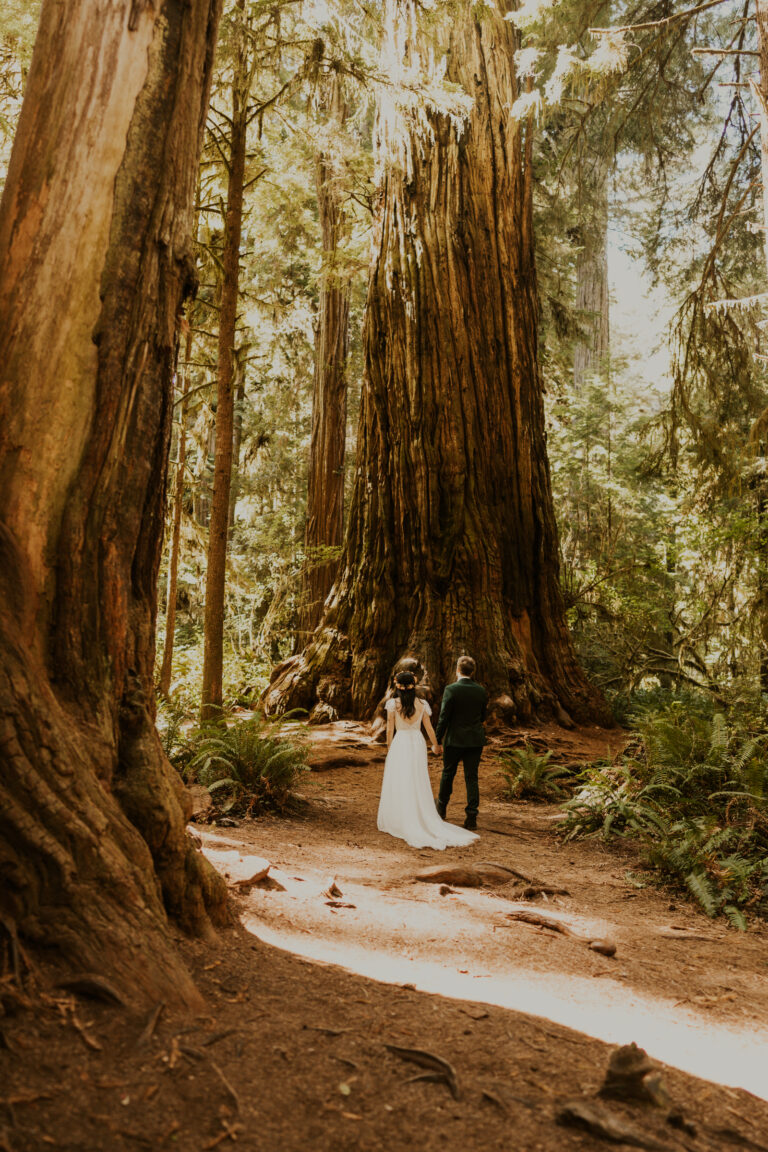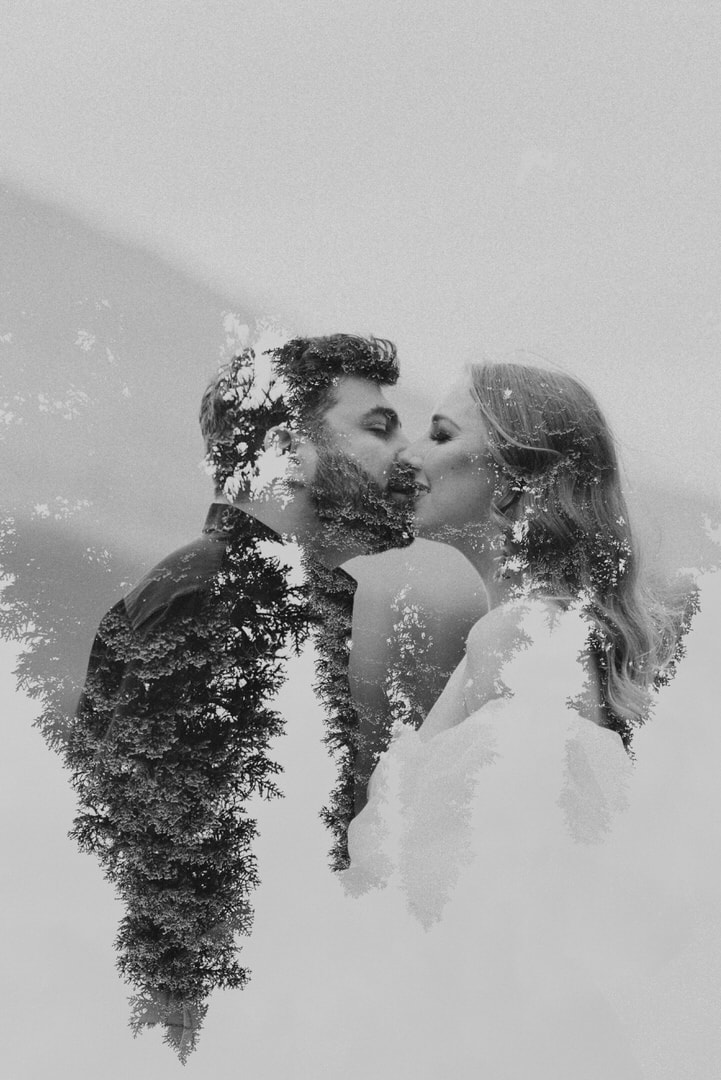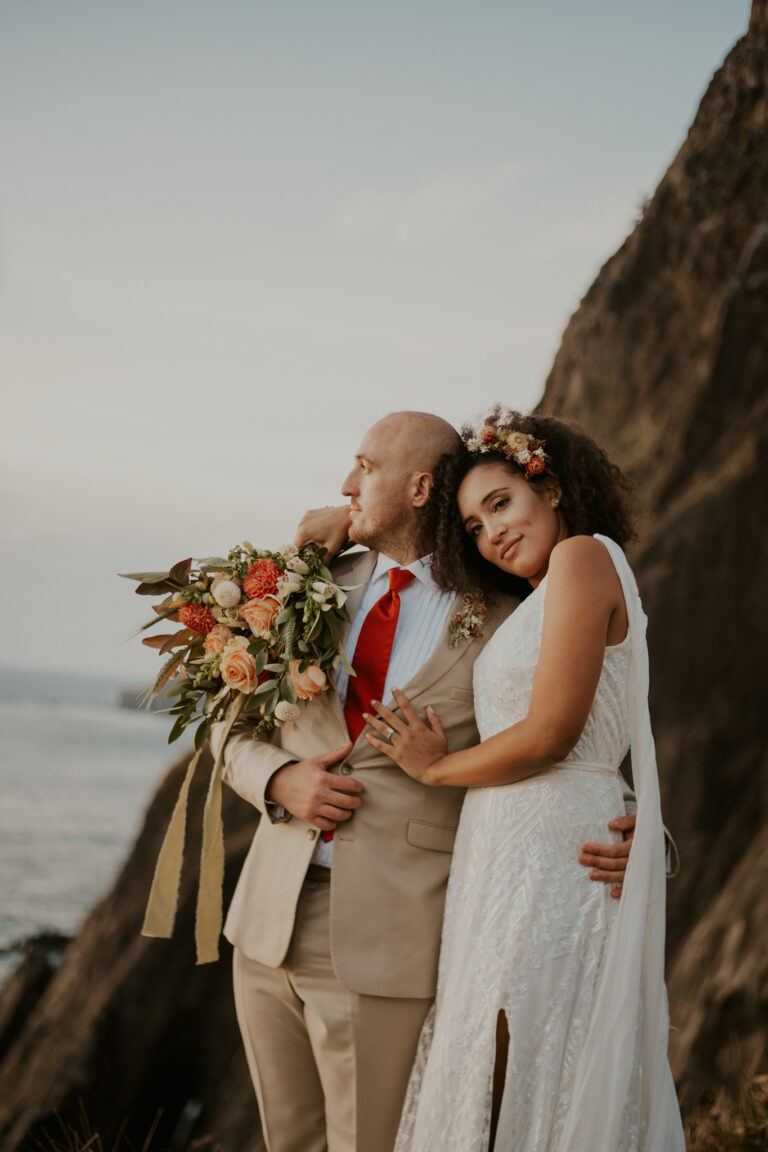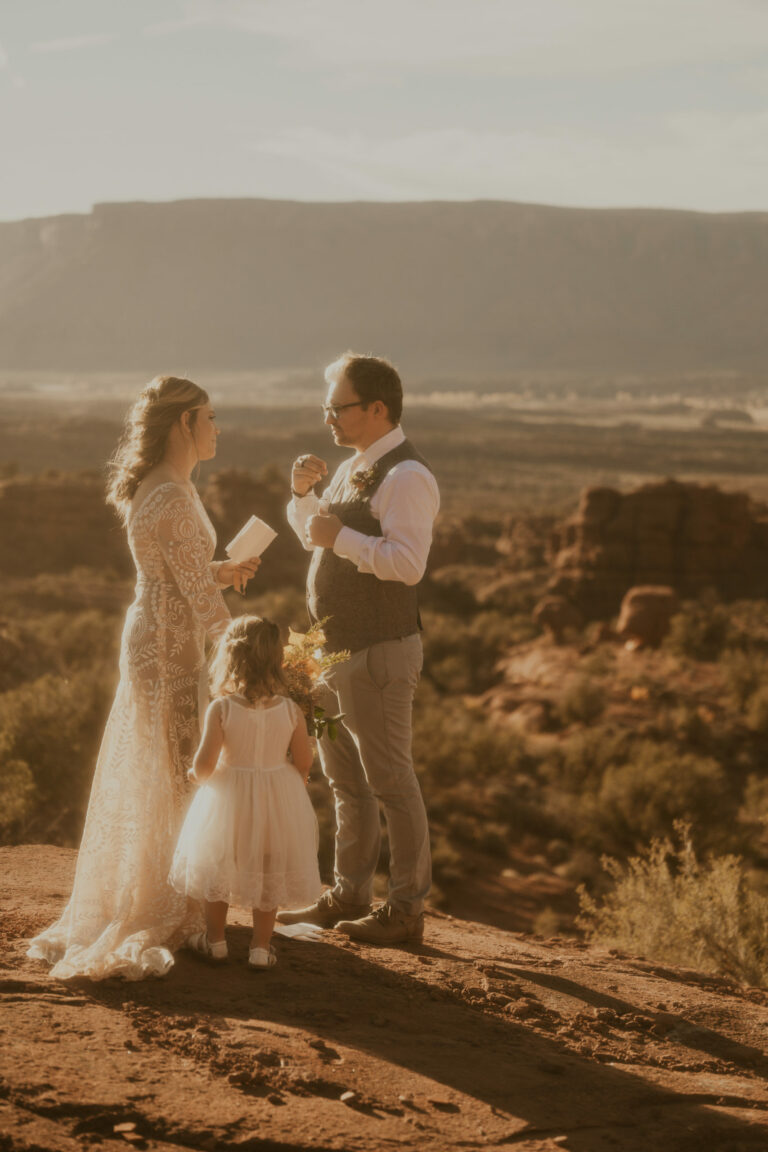How to Plan a Sustainable Wedding
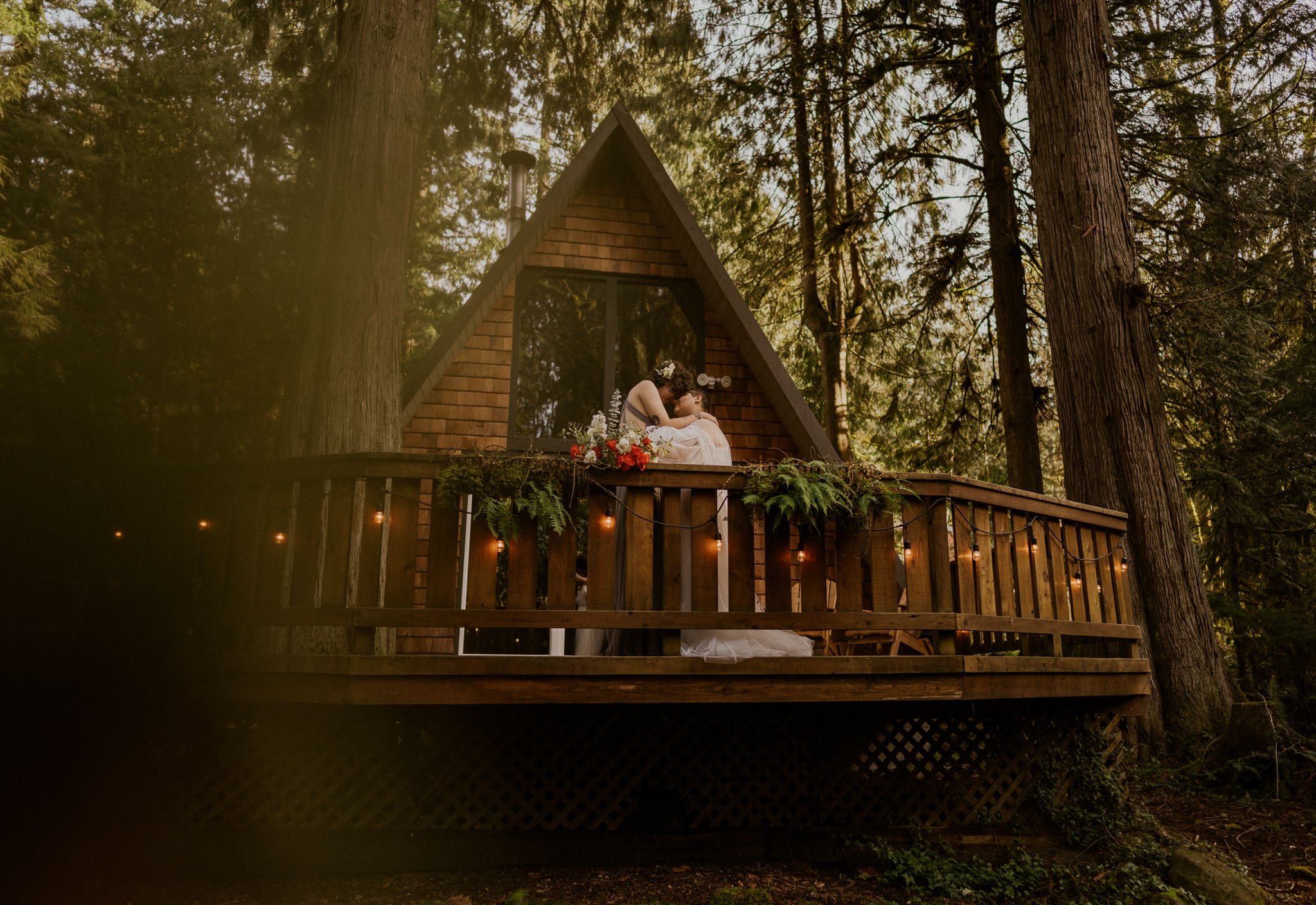
As we all become more aware of climate change and the effect that our choices have on the planet, many couples are taking notice of the fact that weddings are a large culprit when it comes to waste. The average wedding produces a whopping 400 pounds of garbage, and 63 tons of CO2. With about 2.5 million weddings happening every year, that’s about one billion pounds of trash and single use items get discarded, and that trash ends up piling up in landfills.
However, there is still a ton of damage that can be done any time you’re in an outdoor space, and the major culprit is that people aren’t aware of their impact. Nature is more fragile than most people think, and with the increase in people getting outdoors, the outdoor locations we love so much can start to wear, or even close if rangers decide that visitors are being destructive. Many couples choose to elope because they love the outdoors – but a huge perk of eloping is that it’s much better for the environment!
The best way to help the environment is to learn about Leave No Trace and to make your wedding sustainable. This knowledge will help you plan an eco-friendly day, and give you the tools to apply this any time you get outside! With this guide, you’ll learn how to plan a sustainable wedding and use green alternatives where possible.
Get Married Outdoors
Imagine saying your vows amongst Redwood trees, or surrounded by mountains, or getting soaked by Icelandic waterfalls…Getting married outdoors can be a beautiful experience, but it’s also better for the environment!
By tying the knot outside, you save on electricity, and you get to get married in natural light, which is better for photos. In the great outdoors, there is also less need for decorations, which will prevent the excess waste produced by typical weddings.
Practice Leave No Trace
When you opt to get married outdoors, it’s important to be aware of the principles of Leave No Trace, or LNT. This means researching the outdoor space you’ll be in and being aware of the environment. Which surfaces are okay to walk on, how to respect the wildlife, and how to minimize your impact on the land.
You can learn more about LNT organization here. As well, I have taken an educational photographer course to provide myself and my couples with knowledge to incorporate these principles into the whole photo and wedding experience.
What is Leave No Trace?
Leave No Trace is a set of 7 principles created by the Center for Outdoor Ethics. They provide an easy to understand guidance for anyone who visits the outdoors, and the 7 principles can be applied anywhere – from remote backcountry locations to your backyard.
Why should you care about Leave No Trace?
The purpose of Leave No Trace is to educate people on their impacts on the outdoor locations they visit. Practicing these guidelines ensures that parks and outdoor spaces stay beautiful for future generations, and keeps parks from shutting their doors to visitors.
Leave No Trace is vital to elopements, because we’ve already seen the impacts that mistreating the land has on the elopement industry! Many parks have already set limitations on which locations are open for elopements, and how many elopements can take place.
Some locations have even banned wedding ceremonies completely. Following Leave No Trace principles ensures that couples can continue to elope in these beautiful locations for years to come. That is just one of the reasons why it’s so important to plan a Leave No Trace wedding and to be aware of your impact!
We are SO lucky to enjoy these beautiful places, especially those majestic places in nature that allow us to get married for free – outside. Although many feel that these rules and regulations are not applied to just one person, or can be seen as annoying – it’s important to remember to follow these so that you can come back to the same exact place you said “I do” and have it feel AND look the same when you celebrated your marriage.
The 7 Principles of leave no trace
Here are the 7 Principles of LNT:
- Plan Ahead and Prepare.
- Travel and Camp on Durable Surfaces.
- Dispose of Waste Properly.
- Leave What You Find.
- Minimize Campfire Impacts.
- Respect Wildlife.
- Be Considerate of Other Visitors.
Now let’s talk about what this means for elopements!
1. Plan Ahead and Prepare
When you elope outdoors, you need to be informed about the specific rules, regulations, and unique circumstances of that location. Many places require a permit to elope (yes, even for tiny elopement ceremonies!), so make sure to do your research before your elopement day. Be aware of permit requirements, as well as park rules. For example, some parks don’t allow arches or ceremony decorations, while others are more lenient. Be aware of Leave No Trace rules for your location, such as not walking on wildflower fields, or staying off cryptobiotic soil.
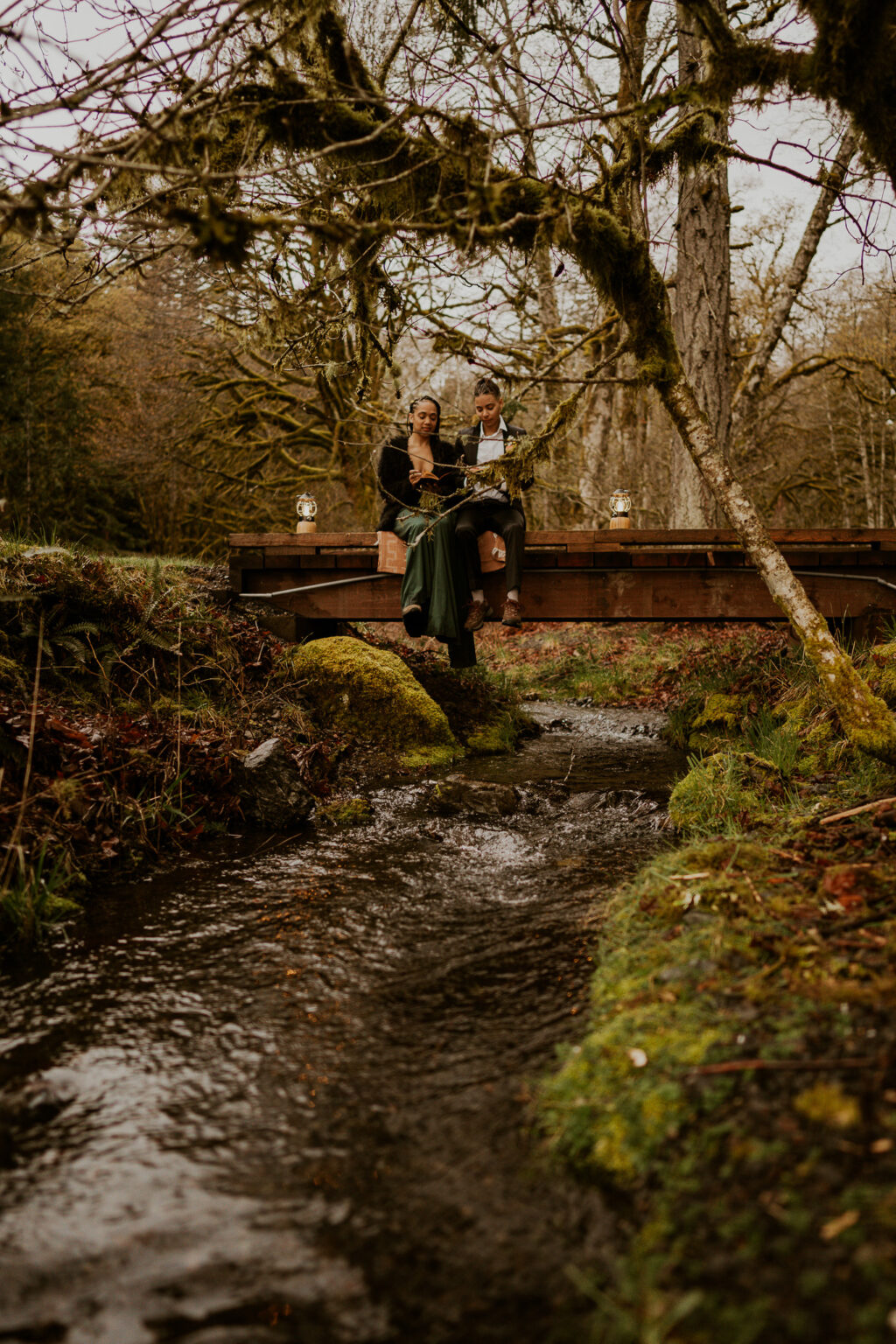
2. Travel and Camp on Durable Surfaces
Speaking of wildflowers and cryptobiotic soil, principle two is about staying on durable surfaces! This means that to have a Leave No Trace elopement, you need to stick to areas that are well traveled and established. No going off trail or taking shortcuts to avoid switchbacks! Try to walk on hard, rocky surfaces and avoid plant life and vegetation. If you’re camping, choose a spot that looks like it’s been used before instead of setting up your tent on some grass that looks like it’s never been stepped on.
It can be tempting to stand amongst some flowers or to veer off the trail for some photos, but keep in mind that the damage done to nature and the environment can be irreversible, and not worth it for a photo op. Take a look below at this photo. We never stepped through the fragile beach grass, but still made an epic photo staying on the trail!
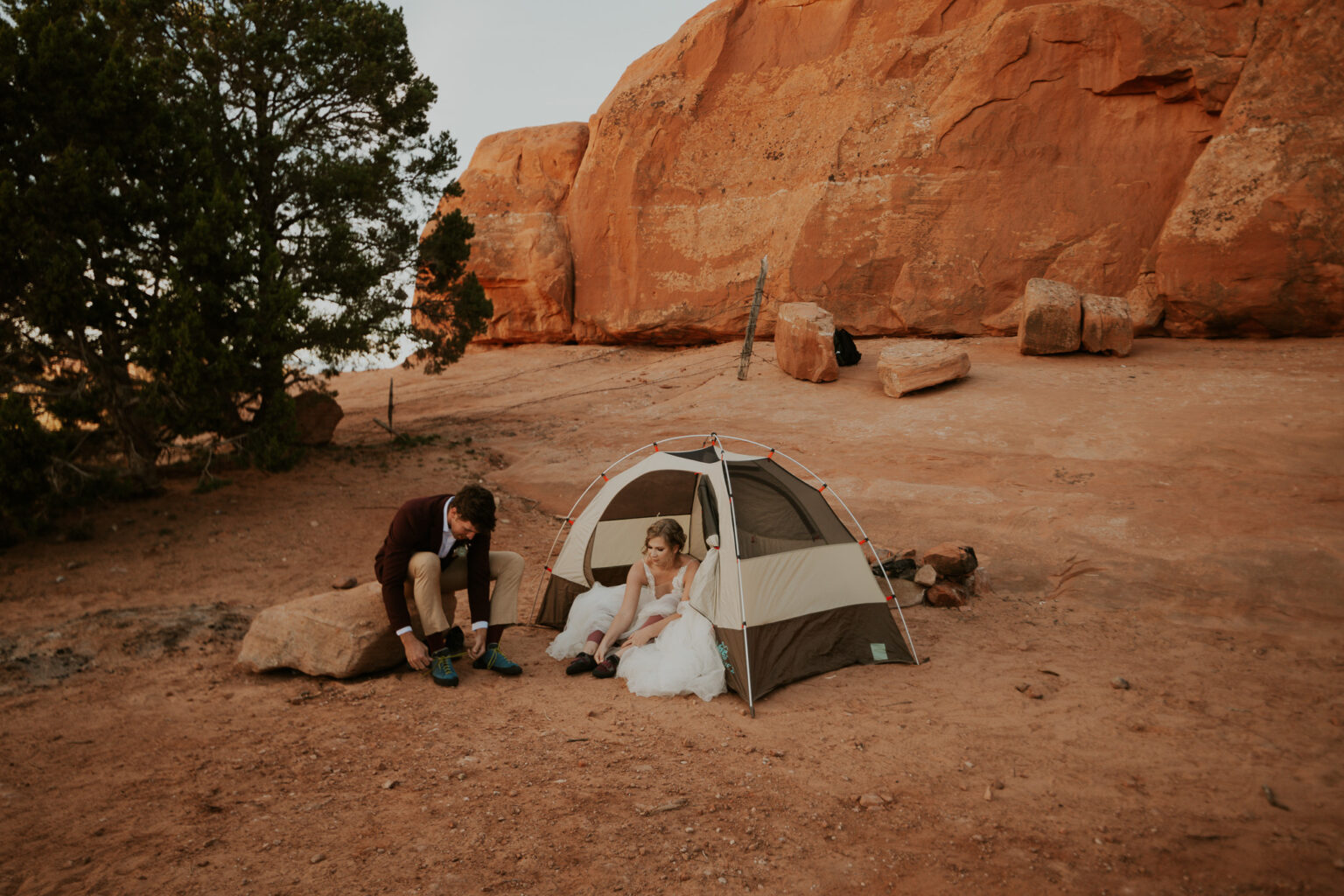
3. Dispose of Waste Properly
Have you ever pulled up to a trailhead or a campsite and seen it covered in trash? There’s nothing worse! Not only is it an eyesore, but it can be deadly to wildlife. Anything you bring with you for your elopement, like water bottles or sandwich bags, make sure to pack it out! John Muir said, “take nothing but pictures, leave nothing but footprints,” and I think this is a great way to think about it! After a Leave No Trace Elopement, there should be no sign that you were ever there. Just like these two below, we enjoyed a nice drink – but made sure to pack out the trash with us.
4. Leave What You Find
Here’s the “take nothing but pictures” part! It may seem harmless to pick a flower, or bring a rock home, but the reality is that if everyone did that, or even if a few people did that, these natural spaces would quickly lose their beauty. Things like carving initials into trees not only hurt the trees, but it ruins the natural beauty for future visitors!
The only exception to this rule is that if someone before you left behind trash, it’s great to take that with you and dispose of it properly!
5. Minimize Campfire Impacts
If you’re planning an overnight backpacking elopement, you might want to set up a campfire. This is totally fine in most places, but make sure there is no burn ban first! In the summer, states like California and Utah, and other dry states are prone to wildfires, and you definitely don’t want your campfire to be the cause.
Once you’ve verified that campfires are allowed, try to only use existing fire rings. When you collect wood, look around. Is there enough wood that using a few branches won’t make a difference? It’s best to use trees or branches that have already fallen, but birds and small animals often use these to make their nests – so if there aren’t very many trees around, consider skipping the campfire.
When you’re ready to go to sleep, extinguish your fire with water, and make sure it’s completely out – even the tiniest ember can lead to devastating forest fires. If you’re wanting to get some unique lighting involved into your photos, just check out these examples below that I love incorporating if we can’t make a campfire!
6. Respect Wildlife
There are countless heartbreaking stories with tragic endings of tourists getting too close to the bison in Yellowstone, or wanting to get a closer look at a bear. Not only is this dangerous, but it’s also incredibly stressful for the animals. Wild animals, even those who are used to being near people, are naturally wary and alert for danger. Though you may not mean to, getting too close can startle them or scare them, which is at best, disrespectful to the animal, and at worst, dangerous or even deadly for you.
When you plan your Leave No Trace elopement, look up what animals can be found in your elopement location, and what precautions need to be taken. If you see an animal, give them space – remember that this is their home, and we are the visitors!
7. Be Considerate of Other Visitors
Throughout your elopement day, it’s likely that you’ll see other people on the trail, and people who are enjoying nature just like you are. If you have guests, remind them to keep noise to a minimum – it’s totally fine to talk, but playing music can be a disturbance to those around you.
For more privacy on your elopement day, I recommend eloping on a weekday! You’ll see a lot less people. While it’s amazing that people are getting outside to enjoy nature, it’s totally understandable that when you get outside, especially on your elopement day, you want to hear the sounds of nature, not people.
For this photo below, we made sure that we arrived early to the trail to avoid high crowds on the trail, as well as making sure to move out of the way if a fellow hiker needed to pass.. This allowed them plenty of intimate time together, capturing epic images like this!
how to Plan Your Sustainable Wedding or elopement
The Earth will thank you for keeping sustainability in mind as you plan your wedding! If you need help planning, don’t hesitate to reach out.
As a photographer who specializes in outdoor elopements, sustainability is high on my list of priorities, and I’m happy to give you some guidance when it comes to sustainability and wedding planning!
if you are looking for other vendors that love sustainability, check out Emerald hour organization. This is the group i’m apart of too that incorporates eco-friendly practices into my business.
Rent Instead of Buying wedding items
Single use items are definitely not good for the environment, as they are usually thrown away immediately after the event. Instead of plastic glasses and paper plates, rent porcelain or ceramic dinnerware!
This will not only reduce your environmental impact, but it will add some elegance and flair to your wedding day. You can also rent linen napkins and tablecloths instead of using paper, and prevent tons of paper and plastic products from ending up in the garbage at the end of the night.
Many wedding decorations can be rented as well, and as an added perk, you can save some money! You can rent candle holders and vases, seating (if you need some), and other decor items that you won’t use again.
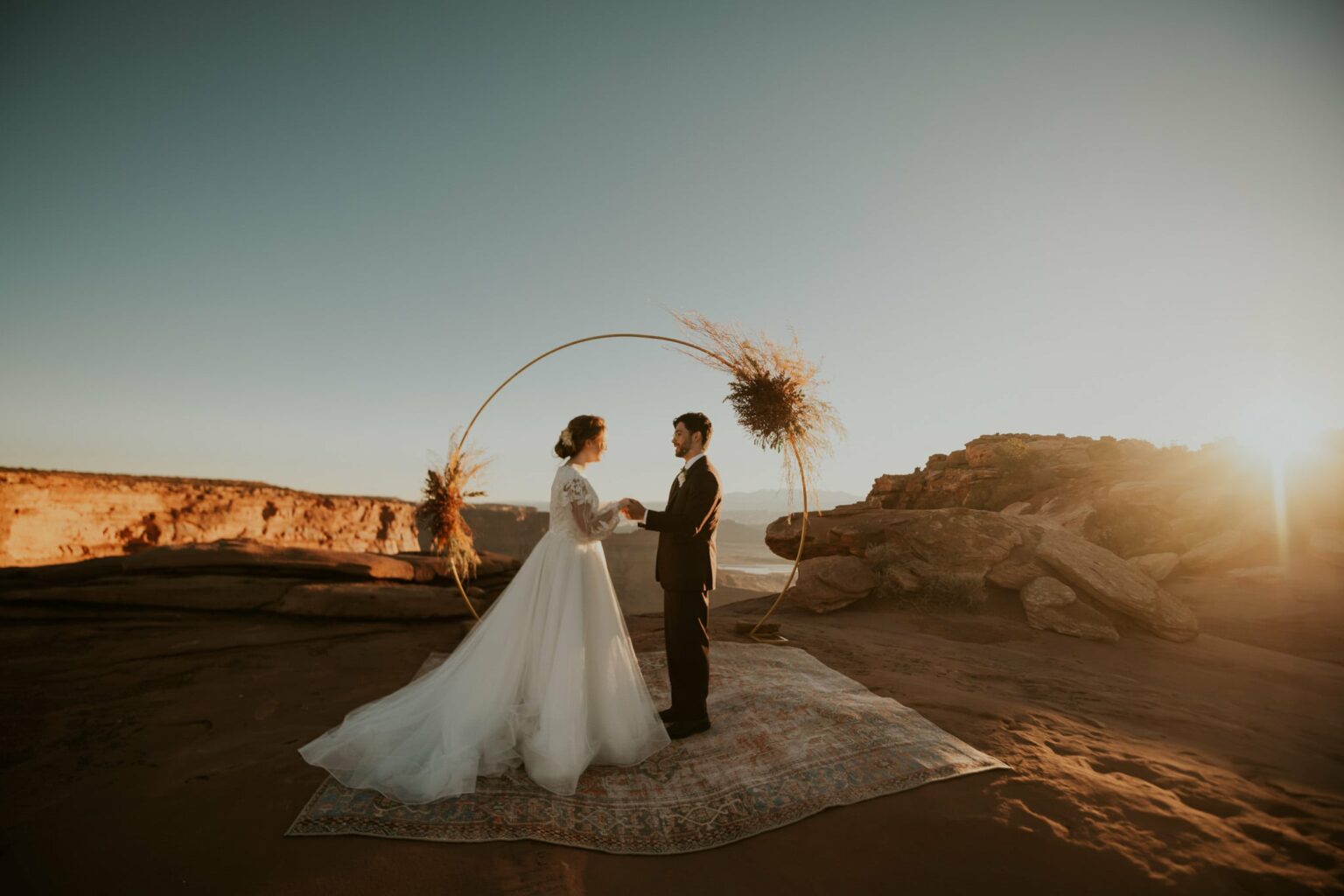
Rethink Your wedding Stationery
Save-the-dates and invitations are a long-held wedding tradition, but it’s hard to deny that they require a lot of paper! The most eco friendly and sustainable wedding option is to opt for virtual save the dates and wedding invitations, but there definitely is something more special about holding a paper invitation in your hand as opposed to looking at it on a computer screen.
If you have your heart set on physical invites, don’t worry! Sustainability is all about making small changes, and there are still a few ways to reduce your carbon footprint.
Many companies, such as Minted, offer the option to print stationery on recycled paper, so you can reuse materials. i also love these plantable flower seed cards! To cut down on waste, couples can also provide their guests the option to RSVP online, which is an option that most wedding websites offer.
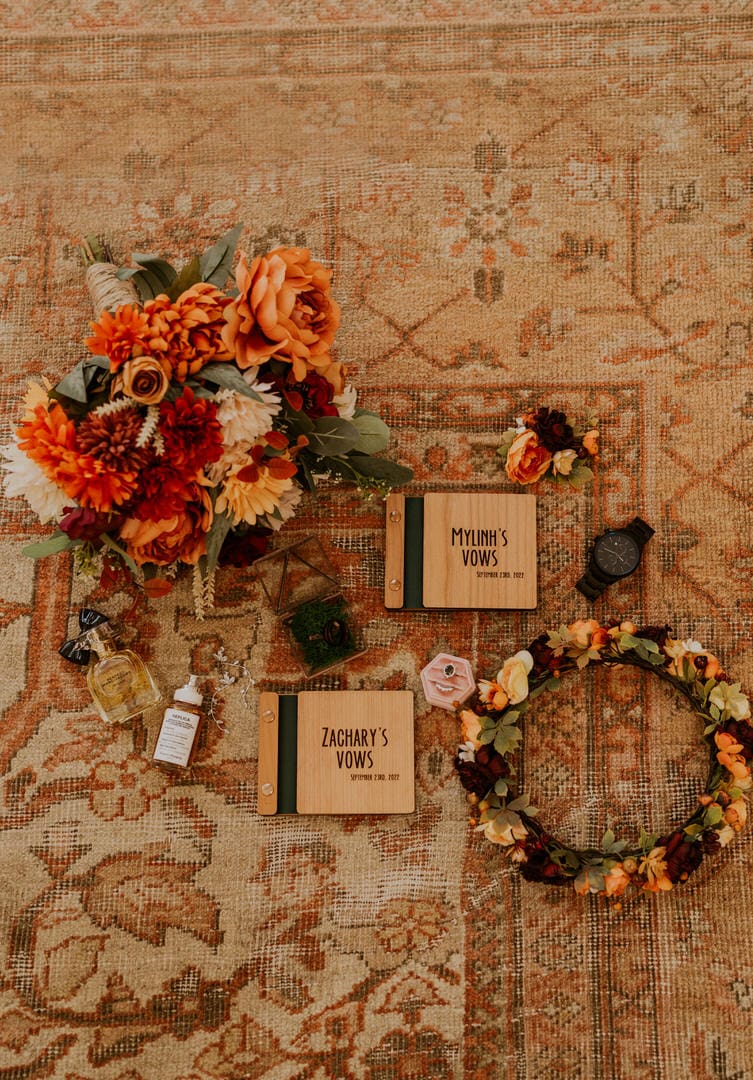
use Sustainably Sourced Florals
You may not think of florals as a high waste item, but in fact, many flowers are sourced from other countries around the world. The shipment and transportation produces a lot of CO2 emissions, and a lot of the growers use pesticides that harm water sources and can contribute to the depletion of the ozone layer..
A more sustainable solution for your wedding blooms is to find flowers that are grown locally and organically. Sustainably sourced flowers are great for the environment, and can also be a great way to support small businesses near your wedding location. If you’re hiring a florist, talk with them about where they source their flowers and how you can work together for more sustainable blooms!
After your wedding, instead of throwing away your flowers, consider donating them to hospitals and nursing homes. More people can enjoy the beautiful arrangements after the big day!
Edible wedding Party Favors
Giving out small gifts to your guests is customary at weddings, but a lot of the time, many of these party favors end up going to waste. Instead of gifting your guests candles or mugs monogrammed with your initials, opt for some local treats.
Support a small business near you instead of buying in bulk from online retailers, and give your guests some snacks to take home. Everyone appreciates a midnight snack to munch on when they’re on their way home from a night of dancing!
Donate your wedding items!
A lot of the items and things you purchase for your wedding can be donated afterwards. Your flowers can be donated to hospitals or nursing homes for others to enjoy, and any decorations that you won’t use again (let’s be honest, most of them you won’t use again) can be donated to thrift stores or to specific organizations that help couples find affordable options for their wedding. While some people like to keep their wedding dresses after the big day, the reality is that you won’t wear it again, and donating your dress can provide someone else with a gorgeous gown to wear on their day. You can donate to a thrift store, or to an organization such as Brides for a Cause. Another bride will get to wear the dress, and feel just as beautiful as you did!
Make Sure to Get Your wedding Permits
If you choose a National park, state Park, or bureau of land management area to get married in, you will likely need to pay a permit fee. don’t let this extra step in your wedding day get you down, i’ll help explain of the details below. Plus, you get to support your public parks instead of paying for a wedding venue!
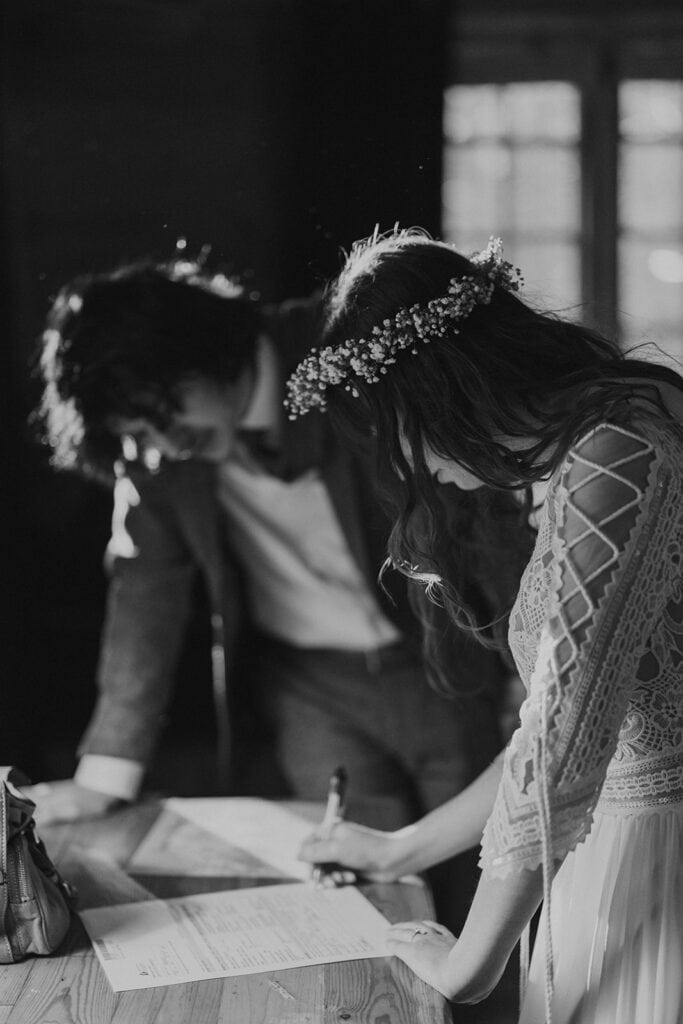
wedding ceremony permits
the first permit you may come across, is a ceremony permit. This legally allows you to hold your wedding ceremony at xx location. note that most parks will have regulations on where you can it in the park and limitations to group sizes.
If you are eloping in a national park, wilderness area, or state park – the group size is usually cut off between 12-15 people. make sure to check this info out before deciding on a final spot or you may be disappointed! *pro tip – if you’re group size is 15+, outdoor wedding venues, group campsites, and other recreational areas may be a better option!
the best way to get your ceremony permit, is to contact the permit ranger directly via email. then, follow up with a phone call if you haven’t heard back in 3-4 weeks.
make sure to let the office know the following info when you reach out to them:
- desired location to hold the ceremony
- your anticipated time for ceremony
- how long it should last
- how many guests and cars will be there
photography/videography permits
Most photographers/videographers will pay and take care of their own permit to legally work in that area – but this is not true for all! Make sure to ask this question and read through the contract you sign with them. There is not a wrong way to do this, it is just a personal preference on what works for them.
permit fees and regulations
EVERY PARK WILL HAVE DIFFERENT RULES and expenses for permits and they are constantly changing… because of this I always recommend reaching out to the particular park asap.
Even if your photographer/planner has worked in that area before, you need to always reach out personally as the couple! This way you have proof of your particular ceremony in case you were stopped by a ranger.
In addition to this, not all permits cost the same. I’ve seen permit cost as little as $50 all the way up to $1,000! So it doesn’t hurt to look into this asap.
Permit fees can determine your location
If you don’t want to pay for a big permit fee or worry about it all, then you should definitely pick a location based off of this desire! Places like that exist for the Oregon Coast (no structure setups or crowds of 50+ more) and a lot of wilderness areas in Idaho are 2 of my top favorites!!
bring proof of your permit
Like I said previously, making sure you have proof of your conversation with the correct office (whether they tell you do or do not need a permit) is super important!! Always bring a printed out copy AND screenshot of any conversations/permits.
There is nothing worse than an official to stop you and you don’t have any proof that you have the right to be there.
Work with a professional that knows how to navigate acquiring a permit
Working with a photographer or a videographer that has personally worked in that park before us very valuable. Although rules change, they will usually be up to date on what is currently standing and who to personally contact!
as your elopement photographer, i will personally let you know who exactly to contact and what to say, saving you the time of researching it all!
A Personal Note From Your Sustainable Leave No Trace Elopement Photographer
Because I’m passionate about preserving our World for future generations, as well as for us to come back year after year again to those special places in nature – I’ve created the ultimate guide to help you plan your own Leave No Trace Wedding.
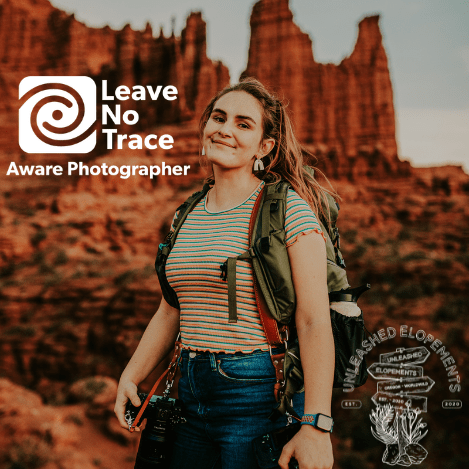
This guide is super easy to download to your computer or mobile device and you can share this link too! This is a perfect way to get educated quickly and allow you to share it with all of your fellow wedding vendors. Now – let’s get out there and explore together for your perfect love story adventure!
xx – Sharlee
Pin Me!
